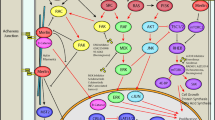Abstract
Purpose
Neurofibromatosis type 1 (NF1), a common genetic disorder, predisposes patients to the development of both benign and malignant tumors. Although the most common central nervous system (CNS) tumor is a low-grade pilocytic astrocytoma of the optic pathway, there have been sporadic reports of NF1 patients with more aggressive CNS lesions. We investigated the incidence of aggressive CNS lesions in NF1 patients at our institution.
Methods
We conducted a retrospective review of all patients with NF1 and any CNS tumor being followed in the Children’s Memorial Hospital NF1 Clinic.
Results
Seven hundred forty patients with a diagnosis of NF1 were identified. Of these, 145 (20%) patients had CNS tumors, 99 (68%) of whom had optic pathway tumors (OPTs). Five patients (3%) were identified as having high-grade tumors, which consisted of anaplastic medulloblastoma (n = 1) and high-grade glioma (n = 4). The mean age at diagnosis of NF1 was 2 years. Three of the five patients had a history of an OPT prior to the development of their high-grade lesions. The clinical courses and treatment of these five patients varied. Currently, two patients are alive and receiving therapy at a mean of 10 months following diagnosis.
Conclusion
High-grade CNS tumors may occur in children with NF1. Although tumors in NF patients are generally benign, clinicians should have a high index of suspicion of malignancy in patients whose tumors are in an unusual location or behave in an uncharacteristically aggressive manner.
Similar content being viewed by others
References
Beigel JAJ, Raffel C, Sutton L, Rorke L, Harper J, Phillips P (1997) Prognostic significance of chromosome 17p deletions in childhood primitive neuroectodermal tumors (Medulloblastomas) of the central nervous system. Clin Cancer Res 3:473–478
Farrell PSC (2007) Genetic causes of brain tumors: neurofibromatosis, tuberous sclerosis, von Hippel–Lindau, and other syndromes. Neurol Clin 2007:925–946
Gutmann DJD, Brown T, James C, Perry A (2000) Loss of neurofibromatosis 1 (NF1) gene expression in NF1-associated pilocyctic astrocytomas. Neuropathol Appl Neurobiol 26:361–367
Gutmann JCD, Poyhonen M, Louis D, Ferner L, Guha A, Hariharan S, Viskochil D, Perry A (2003) Molecular analysis of astrocytomas presenting after age 10 in individuals with NF1. Neurology 61:1397–1400
Gutmann RSD, Wolkenstein P, MacCollin M, Guha A, Inskip P, North K, Poyhonen M, Birch P, Friedman J (2002) Gliomas presenting after age 10 in individuals with neurofibromatosis type 1 (NF1). Neurology 59:759–761
Jukich MBP, Surawicz T, Freels S, Davis F (2001) Trends in incidence of primary brain tumors in the United States, 1985–1994. Neuro-oncology 3:141–151
Lau FMN, Roncari L, Loehr A, Shannon P, Gutmann D, Guha A (2000) Loss of neurofibromin is associated with activation of RAS/MAPK and PI3-K/AKT signaling in a neurofibromatosis 1 astrocytoma. J Neuropathol Exp Neurol 59:759–767
Louis PHD, Wiestler O, Cavenee W (2007) WHO classification of tumors of the central nervous system. International Agency for Research on Cancer, Lyon
Lynch GDT (2002) Neurofibromatosis 1. Neurologic Clinics of North America 20:841–865
Martinez-Lage SCJ, Poza M (2002) Medulloblastomas in neurofibromatosis type 1. Case report and literature review. Neurocirugia 13:128–131
Perilongo FCG, Meadows A, Nowell P, Biegel J, Lange B (1993) Sequential development of wilms tumor, T-cell acute lymphoblastic leukemia, medulloblastoma, and myeloid leukemia in a child with type 1 neurofibromatosis: a clinical and cytogenetic case report. Leukemia 7:912–915
Pollack SBI, Mulvihill J (1996) The management of brainstem gliomas in patients with neurofibromatosis 1. Neurology 46:1652–1660
Rosser PRT (2002) Intracranial neoplasms in children with neurofibromatosis 1. J Child Neurol 17:630–637
Sharif FRS, Birch J, Gillespie J, Gattamaneni H, Baser M, Evans D (2006) Second primary tumors in neurofibromatosis 1 patients treated for optic glioma: substantial risks after radiotherapy. J Clin Oncol 24:2570–2575
Ward GDB (2005) Neurofibromatosis 1: from lab bench to clinic. Pediatr Neurol 32:221–228
Author information
Authors and Affiliations
Corresponding author
Rights and permissions
About this article
Cite this article
Rosenfeld, A., Listernick, R., Charrow, J. et al. Neurofibromatosis type 1 and high-grade tumors of the central nervous system. Childs Nerv Syst 26, 663–667 (2010). https://doi.org/10.1007/s00381-009-1024-2
Received:
Revised:
Published:
Issue Date:
DOI: https://doi.org/10.1007/s00381-009-1024-2




